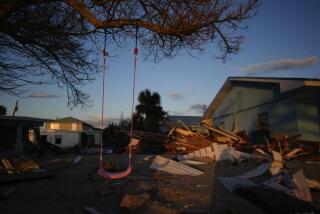AMERICAN ALBUM : Water policies leave Everglades tribe swamped : Heavy rain, along with man-made disruptions and diversions of natural flow, have flooded and enraged the Miccosukees.
MICCOSUKEE INDIAN RESERVATION, Fla. — The wind whipped up whitecaps in the Everglades. Buffalo Tiger’s private camp was under water and mosquito fish were swimming around in Toby Osceola’s little store the other day.
With no high ground on which to rest, hundreds of deer have died--of stress and starvation--and the toll on raccoons, rabbits, rats and mice will never be known.
“I’ve never seen anything like this,” said Steve Tigertail, standing in the bow of his airboat, deep in the watery prairie that flows softly down the spine of South Florida. A few yards ahead, American coots and purple gallinules paddled around a village of thatched-roof dwellings perched on a hummock that ordinarily is an island in the river of grass--and a wetlands classroom for Native American children and tourists. Now it’s three feet under water.
“You know,” added Gene Duncan, the tribe’s water resources director, “we may not even have a wet season this year. And no one knows what the consequences of that might be.”
Four months into what should be the driest time of year here, the 412-square-mile reserve of the tiny Miccosukee nation has never been wetter. Heavy rains, coupled with water-management decisions based on the needs of 4 million South Florida residents and some politically powerful farmers, have left the tribe scrambling for high ground. Water depths are at least two feet above normal, and a foot above anything ever recorded at this time of year.
Over the past six weeks, the Miccosukees have hauled in 31,000 tons of crushed rock--at a cost of $250,000--to build protective dikes around their homes, some of which have already been damaged. The tribe lost three weeks of tourism revenue when the entire village was shut down, and fields where corn is usually planted and cattle normally graze are still inundated.
“It’s outrageous,” said Angel Cortinas, the tribe’s lawyer. “Miami has flood protection, the farmers have water and Everglades National Park is getting its water cleansed--and the tribe is at the mercy of everyone. This is a crisis, and everyone should share the adversity equally. But the Miccosukees get less protection than anyone else.”
*
The distribution of water--and the cycles of wet and dry in the fragile Everglades ecosystem--have always been the fulcrum on which life in South Florida rests. The natural flow of water from the shallow valleys in the state’s center, through Lake Okeechobee and the wetlands and into Florida Bay, have been disrupted by miles of levees and canals. Now the U.S. Army Corps of Engineers and local water managers control who gets wet--and when.
Although the Miccosukees have dominion over a large chunk of the wetlands in South Florida, and operate a thriving bingo and gaming parlor, they are relatively poor and have little political clout. Decimated by Andrew Jackson during the Indian Wars early in the 19th Century and--along with the Seminoles--relocated to Oklahoma, the Miccosukees once were near extinction. But recently their numbers have been growing slowly, and today the tribe has 373 members. Most live on the reservation.
Richard G. Ring, the superintendent of Everglades National Park--which lies to the south of the reservation, in recent weeks has agreed to the opening of floodgates that will draw down the water being held on Miccosukee land. And water is being released through two major canals that lead directly to the ocean.
But so much water is being stored in Lake Okeechobee, and in the conservation area surrounding the reservation, that Duncan and others fear this year’s dry season may never dawn. If high water persists, the nesting cycles of alligators and wading birds will be disrupted, and the loss of smaller animals could send shock waves up and down the food chain.
Cortinas, the tribe’s lawyer, is threatening to sue the federal government so that “the tribe gets the flood protection it’s entitled to.” He charges that the Interior Department and officials of Everglades National Park have pressured water managers to use Native American lands as a filter for water polluted with nutrients by large sugar cane and vegetable growers.
Rick Cook, a spokesman for Everglades National Park, said he is sympathetic to the tribe’s plight. “We had the wettest summer in 36 years, and then tropical storm Gordon hit (in November), and that adds up to some very unusual circumstances. We are allowing a greater flow into the park, and we have volunteered any assistance to the tribe. It’s a careful balancing act.”
In a project that will take millions of dollars and many years, the entire Everglades ecosystem is to be re-plumbed in order to restore the natural sheet-flow of water that is critical to its survival. In the short-run, however, environmentalists are worried.
“The Indians and the wildlife are taking the brunt of this, and there seems little that can be done immediately,” said Joette Lorion of Friends of the Everglades. “This is not a natural disaster, but a man-made disaster.
“The system is sorely compromised, and my concern is: How much more stress can it take while we go about fixing it up?”
Times researcher Anna M. Virtue contributed to this story.
More to Read
Sign up for Essential California
The most important California stories and recommendations in your inbox every morning.
You may occasionally receive promotional content from the Los Angeles Times.










